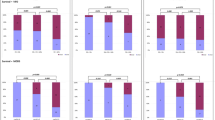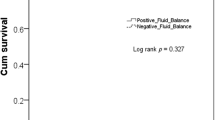Abstract
Fluid administration is essential in patients undergoing hematopoietic stem cell transplant (HSCT). Admission to pediatric intensive care unit (PICU) is required for 11–29% of pediatric HSCT recipients and is associated with high mortality. The objective of this study was to determine if a positive fluid balance acquired during the HSCT procedure is a risk factor for PICU admission. The medical records of 87 consecutive children who underwent a first HSCT were reviewed retrospectively for the following periods: from admission for HSCT to PICU admission for the first group (PICU group), and from admission for HSCT to hospital discharge for the second group (non-PICU group). Fluid balance was determined on the basis of weight gain (WG) and fluid overload (FO). PICU group consisted of 19 patients (21.8%). Among these, 13 (68.4%) developed ≥10% WG prior to PICU admission compared with 15 (22.1%) in the non-PICU group (p < 0.001). Thirteen patients (68.4%) developed ≥10% FO prior to PICU admission compared with 31 (45.6%) in the non-PICU group (p = 0.075). Following multivariate analysis, ≥10% WG (p = 0.018) and cardiac dysfunction on admission for HSCT (p = 0.036) remained independent risk factors for PICU admission. Smaller children (p = 0.033) and patients with a twofold increase in serum creatinine (p = 0.026) were at risk of developing ≥10% WG. This study shows that WG is a risk factor for PICU admission in pediatric HSCT recipients. Further research is needed to better understand the pathophysiology of WG in these patients and to determine the impact of WG prevention on PICU admission.
Similar content being viewed by others
References
Nurnberger W, Michelmann I, Burdach S, Gobel U (1998) Endothelial dysfunction after bone marrow transplantation: increase of soluble thrombomodulin and PAI-1 in patients with multiple transplant-related complications. Ann Hematol 76:61–65
Schots R, Kaufman L, Van Riet I, Ben Othman T, De Waele M, Van Camp B, Demanet C (2003) Proinflammatory cytokines and their role in the development of major transplant-related complications in the early phase after allogeneic bone marrow transplantation. Leukemia 17:1150–1156
Lamas A, Otheo E, Ros P, Vasquez JL, Maldonado MS, Munoz A, Martos I (2003) Prognosis of child recipients of hematopoietic stem cell transplantation requiring intensive care. Intensive Care Med 29:91–96
Diaz MA, Vicent MG, Prudencio M, Rodriguez F, Marin C, Serrano A, Sevilla J, Casado J, Madero L (2002) Predicting factors for admission to an intensive care unit and clinical outcome in pediatric patients receiving hematopoietic stem cell transplantation. Haematologica 87:292–298
Jacobe SJ, Hassan A, Veys P, Mok Q (2003) Outcome of children requiring admission to an intensive care unit after bone marrow transplantation. Crit Care Med 31:1299–1305
Hayes C, Lush RJ, Cornish JM, Foot AM, Henderson J, Jenkins I, Murphy P, Oakhill A, Pamphilon DH, Steward CG, Weir P, Wolf A, Marks DI (1998) The outcome of children requiring admission to an intensive care unit following bone marrow transplantation. Br J Haematol 102:666–670
Foland JA, Fortenberry JD, Warshaw BL, Pettigano R, Merritt RK, Heard ML, Rogers K, Reid C, Tanner AJ, Easley KA (2004) Fluid overload before continuous hemofiltration and survival in critically ill children: a retrospective analysis. Crit Care Med 32:1771–1776
Goldstein SL, Currier H, Graf JM, Cosio CC, Brewer ED, Sachdeva R (2001) Outcome in children receiving continuous venovenous hemofiltration. Pediatrics 107:1309–1312
Michael M, Kuehnle I, Goldstein SL (2004) Fluid overload and acute renal failure in pediatric stem cell transplant patients. Pediatr Nephrol 19:91–95
Lane PH, Mauer SM, Blazar BR, Ramsay NK, Kashtan CE (1994) Outcome of dialysis for acute renal failure in pediatric bone marrow transplant patients. Bone Marrow Transplant 13:613–617
Schwartz GJ, Haycock GB, Edelmann CM Jr, Spitzer A (1976) A simple estimate of glomerular filtration rate in children derived from body length and plasma creatinine. Pediatrics 58:259–263
Schwartz GJ, Feld LG, Langford DJ (1984) A simple estimate of glomerular filtration rate in full-term infants during the first year of life. J Pediatr 104:849–854
National Kidney Foundation (2002) K/DOQI clinical practice guidelines for chronic kidney disease. Evaluation, classification and stratification. Am J Kidney Dis 39 (Suppl 1):S1–S266
Merouani A, Shpall EJ, Jones RB, Archer PG, Schrier RW (1996) Renal function in high-dose chemotherapy and autologous hematopoietic cell support treatment for breast cancer. Kidney Int 50:1026–1031
Bellomo R, Ronco C, Kellum JA, Mehta RL, Palevsky P, Acute Dialysis Quality Initiative Workgroup (2004) Acute renal failure- definition, outcome measures, animal models, fluid therapy and information technology needs: the Second International Consensus Conference of the Acute Dialysis Quality Initiative (ADQI) Group. Crit Care 8:R204–R212
Silverman NH (1993) Pediatric echocardiography. Lippincott William & Wilkins: xii, Baltimore c, p 628
Jones RJ, Lee KS, Beschorner WE, Vogel VG, Grochow LB, Braine HG, Vogelsang GB, Sensenbrenner LL, Santos GW, Saral R (1987) Venoocclusive disease of the liver following bone marrow transplantation. Transplantation 44:778–783
Nürnberger W, Willers R, Burdach S, Göbel U (1997) Risk factors for capillary leakage syndrome after bone marrow transplantation. Ann Hematol 74:221–224
Rosenstein M, Ettinghausen SE, Rosenberg SA (1986) Extravasation of intravascular fluid mediated by the systemic administration of recombinant interleukin 2. J Immunol 137:1735–1742
Nurnberger W, Michelmann I, Petrik K, Holthausen S, Willers R, Lauermann G, Eisele B, Delvos U, Burdach S, Gobel U (1993) Activity of C1 esterase inhibitor in patients with vascular leak syndrome after bone marrow transplantation. Ann Hematol 67:17–21
Woods WG, Ramsay NK, Weisdorf DJ, Haake R, Vallera DA, Kim TH, Lasky L, Nesbit ME, Bostrom B, Uckun F, Goldman AI, Kersey JH (1990) Bone marrow transplantation for acute lymphocytic leukemia utilizing TBI followed by high doses of cytosine arabinoside: lack of superiority over cyclophosphamide-containing conditioning regimens. Bone Marrow Transplant 6:9–16
DiCarlo JV, Alexander SR, Agarwal R, Schiffman JD (2003) Continuous veno-venous hemofiltration may improve survival from acute respiratory distress syndrome after bone marrow transplantation or chemotherapy. J Pediatr Hematol Oncol 25:801–805
Parikh CR, McSweeney P, Schrier RW (2005) Acute renal failure independently predicts mortality after myeloablative allogeneic hematopoietic cell transplant. Kidney Int 67:1999–2005
Bonventre JV, Zuk A (2004) Ischemic acute renal failure: an inflammatory disease? Kidney Int 66:480–485
Molitoris BA, Sutton TA (2004) Endothelial injury and dysfunction: role in the extension phase of acute renal failure. Kidney Int 66:496–499
Bunchman TE, McBryde KD, Mottes TE, Gardner JJ, Maxvold NJ, Brophy PD (2001) Pediatric acute renal failure: outcome by modality and disease. Pediatr Nephrol 16:1067–1071
Acknowledgements
The authors thank Lubo Alexandrov and Cathy Houde for providing their support with statistical analysis and access to the HSCT program database. Data management is supported by Leucan and the Fondation Charles-Bruneau.
Author information
Authors and Affiliations
Corresponding author
Rights and permissions
About this article
Cite this article
Benoit, G., Phan, V., Duval, M. et al. Fluid balance of pediatric hematopoietic stem cell transplant recipients and intensive care unit admission. Pediatr Nephrol 22, 441–447 (2007). https://doi.org/10.1007/s00467-006-0331-z
Received:
Revised:
Accepted:
Published:
Issue Date:
DOI: https://doi.org/10.1007/s00467-006-0331-z




